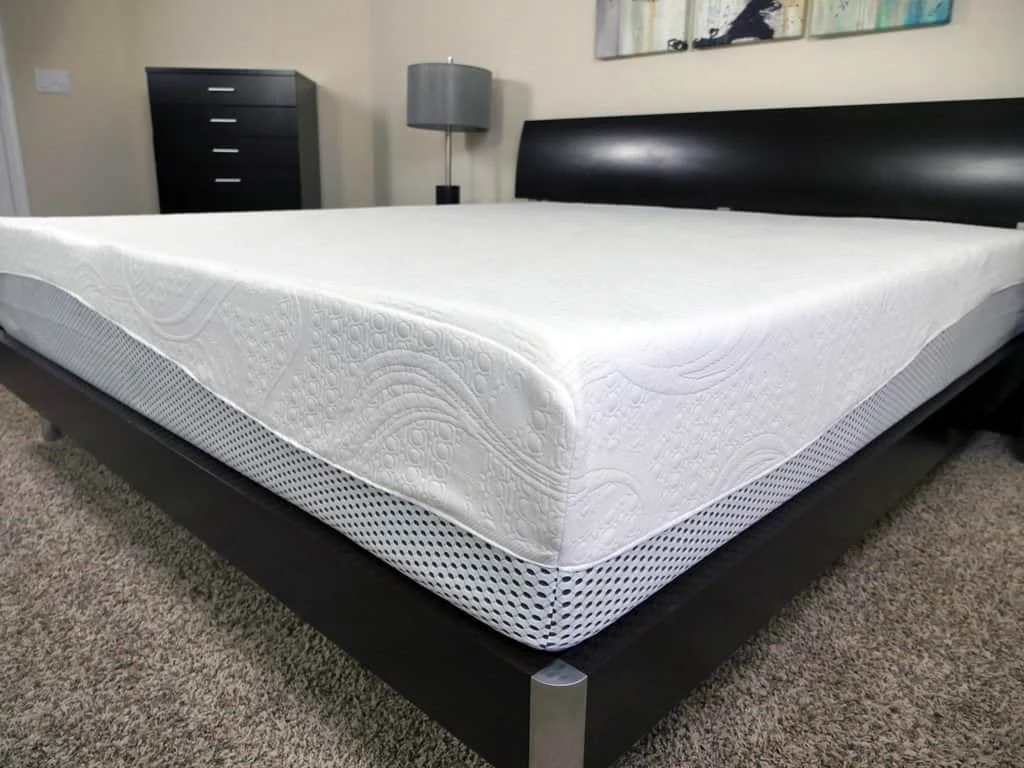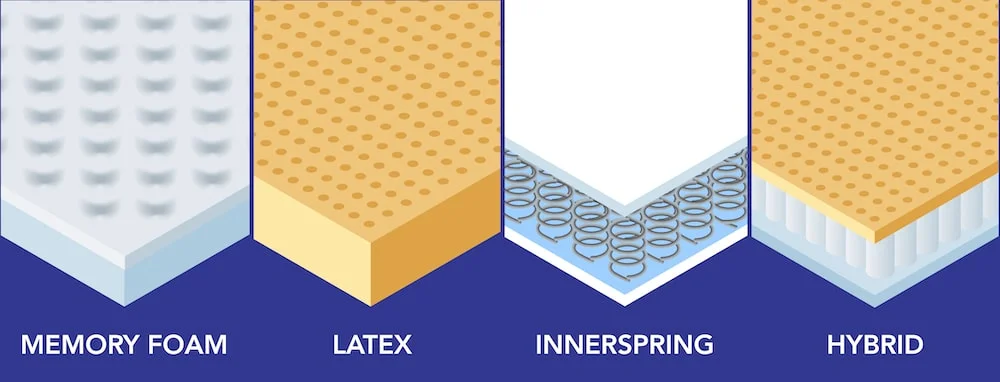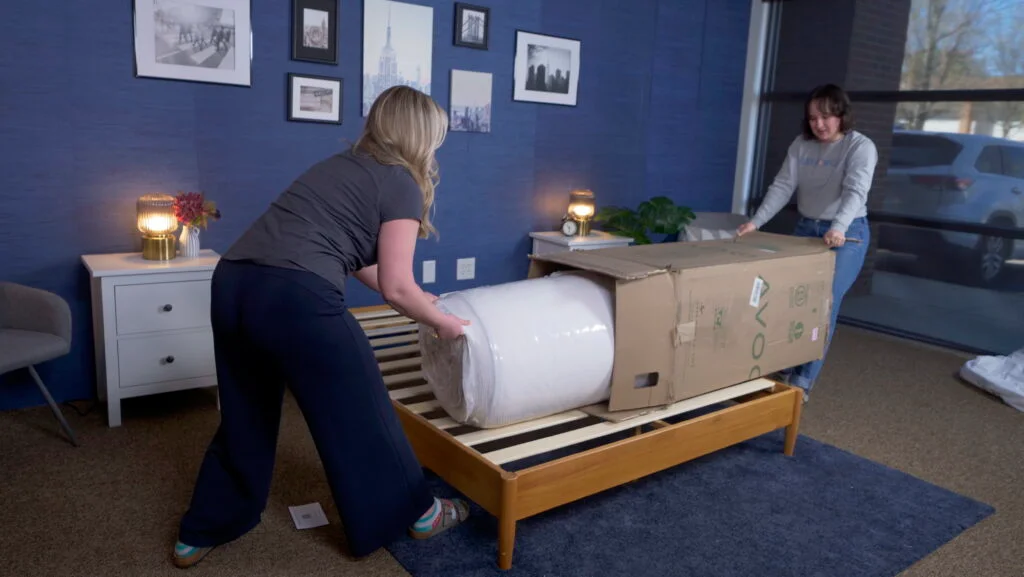Nowadays, shopping for a new mattress is really quite easy, especially with so many bed-in-a-box options. However, receiving a mattress compressed in a box can have some drawbacks — with one of the big ones being an improper expansion, along with an off-gassing period that can take between 24 and 48 hours to go away.
So, if you just received your brand new memory foam mattress and the corners aren’t expanding, it can be pretty frustrating. But don’t worry. We’ve put together this guide to list some reasons why your mattress might be being stubborn, and some solutions on how to get rid of this problem and get some beauty sleep.
Why Isn’t My Memory Foam Mattress Expanding?

If this is a problem you’re currently having, then you know how frustrating it can be. Unfortunately, there’s not always one specific reason when this might be occurring. However, there are some reasons that are more prevalent than others.
Common Reasons for Saggy Corners
- Your mattress sat in the box for too long. Most mattress manufacturers recommend that you unpack your new mattress within 72 hours of receiving it. This is because leaving your mattress compressed in its box for too long can cause problems with its expansion once you do finally take it out (most notably around the corners). Short story — don’t get lazy when it comes to unpacking your mattress!
- Your mattress needs more time. Typically, memory foam mattresses take up to 72 hours to expand fully, especially if your mattress is a larger size. So, if your mattress has only been unpacked for a couple of hours, there’s no need to worry about the corners. They might just be taking their time.
- Your mattress is too dense (or too thick). Thicker mattresses take longer to compress, so they also take longer to expand once they’re out of their box. This same rule also applies to mattresses that use denser foam in their construction. Think of it like this: the more foam that needed to be compressed, the more time that foam needs to expand.
- Your room is a on the chillier side. The viscoelastic chemicals in memory foam are temperature-sensitive (think of them like a rubber band that’s harder to pull when it’s cold). So if you enjoy a colder temperature in your room, your mattress might have a harder time achieving its full size. The good thing about this problem is its easy to fix. Just leave your mattress in a warmer environment to make sure that it expands quicker and fuller.
- Your mattress is defective. As disappointing as it is, some memory foam mattresses (and especially cheap ones) often arrive defective. These beds can feel lumpy or have flat edges and corners that just don’t expand, even after trying out the solutions on this list.
Which Mattresses Take Longer to Expand?

These days, there are several different mattress types on the market, each one offering a unique sleeping experience to their users. Along with these different materials comes longer or shorter unboxing periods, and some mattress types are more or less prone to having saggy corners after removing them from the box.
Mattress Types and Their Usual Unboxing Period
- Innerspring mattress. These mattresses typically don’t include many foam layers in their construction. Because of this, once you remove your innerspring mattress from its box and rip through the vacuum seal, it should expand pretty quickly. As an added plus, the coils included in innerspring mattresses are usually enforced around the edges, which prevents sagging and sinkage at the corners and sides of your bed, ensuring strong edge support.
- Hybrid mattress. By definition, hybrid mattresses include both foams and coils in their construction, so they expand fairly easily — almost as fast as an innerspring.
- Latex mattress. Latex mattresses have a naturally spongy and responsive texture, so once they’re released from their box, they usually spring back into shape pretty quickly. Mattresses made from softer latex might need a bit more time to expand, but overall, it’s uncommon for a new latex mattress to sag, even around the corners.
- Memory foam mattress. Since we’ve written a whole article about the sagging capacity of these mattresses, you can probably guess that they usually take the longest to expand once released from their boxes. Most modern memory foam mattresses need anywhere from six to 24 hours to expand properly. However, cheaper mattresses or models that are made of traditional viscous memory foam might take longer than this, and sometimes, the way they are compressed means their corners are naturally saggy once expanded. So, if you’re set on purchasing a new memory foam mattress, keep in mind that saggy corners are a possible risk.
What to Do If Your Mattress Corners Don’t Expand?

Now that we’ve told you what some of the most common reasons for saggy corners in your memory foam mattress are, you’re probably wondering, how exactly do I solve this problem? Don’t worry, we’re not leaving you high and dry. Even if your new mattress doesn’t originally expand properly, there are some steps you can take in order to help you fix the issue.
Put Your Mattress on the Floor
If your bed frame isn’t suitable for a memory foam mattress, this may cause uneven expansion. The best thing to do is try putting your mattress on the floor and give it a bit more time to expand.
First thing’s first: make sure that your floor is clean and nothing sharp is laying around. This is because many foam mattresses contain fiberglass, a material that can escape if the cover of the bed gets punctured. Fiberglass can be dangerous when it is exposed to your skin, so just to be on the safe side, vacuum the floor thoroughly before putting your mattress there to expand. If you’re worried about the effects of fiberglass in general, you might also want to look at our roundup of the best memory foam mattresses without fiberglass to be on the safe side.
Warm Up Your Room
As we stated earlier, a warmer atmosphere encourages memory foam expansion. Because of this, changing your room temperature to at least 68 degrees Fahrenheit (or more) can help your mattress corners to more evenly expand. While some online experts might instruct you to use steam on your mattress corners when they don’t immediately expand, we here at Sleepopolis don’t recommend this technique. This is because using a steamer too close to your new memory foam mattress can lead to moisture accumulation. And this can lead you down a rabbit hole of issues, including mold growth and dust mites. By heating up your whole room, you won’t put too much moisture too close to your new mattress.
Massage Your Mattress
No matter how ridiculous this may sound, giving your new mattress a little massage by rolling on top of it may help its corners to expand more evenly and quickly. You can even walk around on top of your mattress for around 10–20 minutes to speed up this process (but make sure that your feet are clean before doing so).
Open Your Windows
Promoting air circulation in your room can help your mattress expand fully. This solution goes hand in hand with warming up your room. By opening your windows and allowing a draft to enter your room, your mattress can get some much needed temperature change and airflow circulation. As an added bonus, airing out your room can also help get rid of the off-gassing smell that comes with most bed-in-a-box mattresses.
Return Your Mattress
While we hate to be the ones to have to tell you this, it is important to note that if your mattress doesn’t expand fully within the first week of receiving it, chances are it’s probably defective. In this case, the best (and only) solution would be to return it and pick a better quality model (which you can find here, in our roundup of the best memory foam mattresses). Obviously, this is the worst-case scenario when it comes to saggy corners, but it’s important to know when you might be out of options. If your bed is defective, you might have to compress it again in order to ship it back to the company (or, if your trial period is up, to donate or recycle it). You can also use a pick-up service, but those can get quite pricey.

Conclusion
In the end, there really is nothing more annoying than flat corners on your new memory foam mattress. But, as we’ve outlined above, there are ways to fix this problem before giving up and sending it back for a new one. However, it’s good to keep in mind that, in some cases, returning the bed altogether might be the best option. Higher quality mattresses are less likely to have issues with expansion and can guarantee your peace of mind.


























